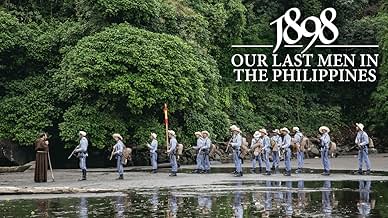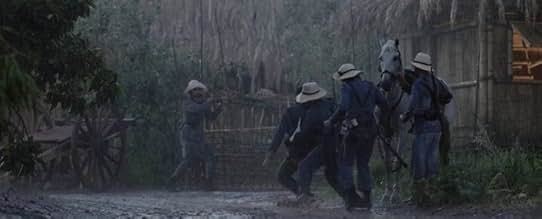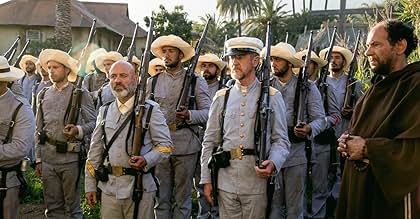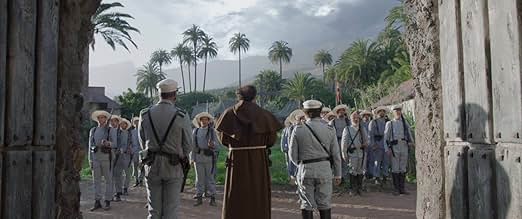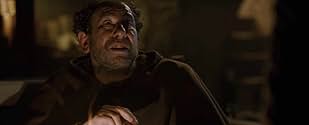1898: Our Last Men in the Philippines
Originaltitel: 1898. Los últimos de Filipinas
IMDb-BEWERTUNG
6,5/10
3747
IHRE BEWERTUNG
Ein Soldat, der als letzter Flüchtling in einer Kirche gefangen ist. Ein Kampf, den niemand gewinnen konnte. Ein Krieg, den niemand verlieren wollte.Ein Soldat, der als letzter Flüchtling in einer Kirche gefangen ist. Ein Kampf, den niemand gewinnen konnte. Ein Krieg, den niemand verlieren wollte.Ein Soldat, der als letzter Flüchtling in einer Kirche gefangen ist. Ein Kampf, den niemand gewinnen konnte. Ein Krieg, den niemand verlieren wollte.
- Regie
- Drehbuch
- Hauptbesetzung
- Auszeichnungen
- 1 Gewinn & 16 Nominierungen insgesamt
Empfohlene Bewertungen
Not sure how accurate this film is.. but i totally enjoyed it.
A patriotic film in which Filipino revolutionaries laid siege to a fortified church manned by colonial Spanish troops in the town of Baler .
This successful ¨Los Ultimos De Filipinas¨is set during the time of the Spanish-American War , 1898 , at a place located on the eastern coast of Luzon, is some 225 kilometers distant from the Philippine capital city of Manila . There is a Spanish detachment in Baler , in the Philippines, it was garrisoned by a fifty-man detachment of the 2nd Expeditionary Battalion "Cazadores" of Philippines , under Captain Enrique Morenas y Fossí (Eduard Fernandez) , as the Principe district political-military governor , along with lieutenant Martin Cerezo (Luis Tosar ) , Sargento Jimeno (Javier Gutiérrez) and Doctor Vigil (Carlos Hipolito ) . Commandant Morenas realizes that the native people of his district are planning an insurrection . He orders his troops to entrench in the village church and being strongly stranded . On June 1, 1898 , Morenas began work to dig a well , stock food supplies and ammunition and to fortify the church compound of San Luís De Tolosa in Baler's town square against a possible attack . The church was the only stone building in the area , it was besieged by the Tágalos rebels . During their stay , which is prolonged for nearly a year , there are several incidents ; suffering enemy bullets , starvation and illness , such as beriberi , dysentery , and fevers which demonstrate sacrifice and braveness of the Spanish military . At the end took place a peace treaty (Paris) between Spain and USA .There are men they want medals and men they want come back.
The jingoist flick attempts to glorify and praise the bold acts and tenacity of the Spanish people , showing their bravura and comradeship , but there is also a sour critique to useless heroism . A well pace movie with nice narrating structure taken from famous American warlike films , being professionally made . The cast is pretty good , such as Alvaro Cervantes as a valiant and upright soldier as well as a brave courier , Eduard Fernandez as supreme commandant , Luis Tosar as stubborn lieutenant , Carlos Hipolito as a good doctor and the veteran Karra Elejalde as Fray Carmelo . And other important actors appearing as Miguel Herrán , Pedro Casablanc ,Ricardo Gómez , Ciro Miró and Patrick Criado as a deserter .This is a reboot based on the 1945 classy version by Antonio Román with Jose Nieto , Guillermo Marin , Conrado San Martin , Manolo Moran , Tony Leblanc , Fernando Rey and Nani Fernández . This is the best of 40's productions exalting the Spanish heroism , such as ¨Escuadrilla¨, ¨Harka¨, ¨El Santuario No Se Rinde¨, ¨Raza¨ and ¨ The siege of Alcázar¨ .
The film packs a colorful cinematography by Alex Catalá , shot on exotic location in Jungle Equatorial Guinea , and the Village and Church was filmed in Gran Canaria, Canary Islands, , Santa Lucía de Tirajana, Gran Canaria, Tenerife, Canary Islands,UNESCO Biosphere Reserve . And a thrilling as well as evocative musical score by Roque Baños . The picture pays tribute to a gorgeous song which in first rendition was performed by a beautiful Tágala woman : Nani Fernandez , who sings the famous song ¨Yo Té diré¨ by maestro composer Halpern . This ¨Propaganda¨ motion picture was well directed by Salvador Calvo , a good filmmaker at his best . Here Calvo surprises us with a historical film plenty of feats , adventures and heroic deeds . Salvador is a Spain's very celebrated filmmaker , he has made a lot of of TV movies . Being stunning and compellingly directed by Salvador Calvo who has made successful TV Series and episodes such as ¨Lo Que Escondían Sus Ojos¨ , ¨Mario Conde¨ , ¨La Duquesa¨ , ¨Askrana¨ , ¨Paquirri¨ , ¨Cuentame Un Cuento¨ , and has directed for cinema this hit ¨Los Ultimos De Filipinas¨ .
The historic facts are : The siege took place for 11 months, or 337 days. On June 1, 1898, Morenas began the impregnable defense . On the night of the 30th , 800 Filipino troops attacked, and the garrison fell back to the church. The town priest, Candido Gómez Carreño, also quartered himself in the church. The first few days of the siege saw several attempts by the Filipinos to get the Spanish to surrender by leaving letters, while they surrounded the church with trenches. On July 8 the Revolutionary Commander, offered a suspension of hostilities until nightfall, which was accepted.On July 18, Calixto Villacorta took command of the Filipinos . He also sent a warning letter, which was rebuffed. The Spanish had to endure confinement in a small, hot, humid space. As the siege progressed, their food supply began to diminish through usage and spoilage. Enemy rifle fire did cause casualties but diseases did more damage. The first Spaniard to die was Gómez Carreño.In September, Lt. Alonso, and then in November, Captain Las Morenas succumbed to beriberi. Command fell to Lt. Saturnino Martín Cerezo when Las Morenas died in December. More than once the Spanish made forays to burn nearby houses to deprive the Filipinos of much needed cover.The Filipinos attempted to smoke them out by setting fires beside the church wall but this was repulsed and their timber captured. Of the fifty men who entered the church, around thirty survived the 11-month siege. Fourteen men died from disease. Only two men died from wounds. There were four deserters from the garrison. Two men were imprisoned for helping in the desertion of another , and executed on orders of Martin Cerezo on June 1, 1899, the day before the surrender . The battle is considered part of the Spanish-American War since the Filipinos were allied with the United States at the outset. That war ended in December 1898 with Spain's surrender and annexation of the Philippines to the United States. However, cut off from communications with their own government and military, the Spanish forces continued their defense against the Filipino forces until 1899
The jingoist flick attempts to glorify and praise the bold acts and tenacity of the Spanish people , showing their bravura and comradeship , but there is also a sour critique to useless heroism . A well pace movie with nice narrating structure taken from famous American warlike films , being professionally made . The cast is pretty good , such as Alvaro Cervantes as a valiant and upright soldier as well as a brave courier , Eduard Fernandez as supreme commandant , Luis Tosar as stubborn lieutenant , Carlos Hipolito as a good doctor and the veteran Karra Elejalde as Fray Carmelo . And other important actors appearing as Miguel Herrán , Pedro Casablanc ,Ricardo Gómez , Ciro Miró and Patrick Criado as a deserter .This is a reboot based on the 1945 classy version by Antonio Román with Jose Nieto , Guillermo Marin , Conrado San Martin , Manolo Moran , Tony Leblanc , Fernando Rey and Nani Fernández . This is the best of 40's productions exalting the Spanish heroism , such as ¨Escuadrilla¨, ¨Harka¨, ¨El Santuario No Se Rinde¨, ¨Raza¨ and ¨ The siege of Alcázar¨ .
The film packs a colorful cinematography by Alex Catalá , shot on exotic location in Jungle Equatorial Guinea , and the Village and Church was filmed in Gran Canaria, Canary Islands, , Santa Lucía de Tirajana, Gran Canaria, Tenerife, Canary Islands,UNESCO Biosphere Reserve . And a thrilling as well as evocative musical score by Roque Baños . The picture pays tribute to a gorgeous song which in first rendition was performed by a beautiful Tágala woman : Nani Fernandez , who sings the famous song ¨Yo Té diré¨ by maestro composer Halpern . This ¨Propaganda¨ motion picture was well directed by Salvador Calvo , a good filmmaker at his best . Here Calvo surprises us with a historical film plenty of feats , adventures and heroic deeds . Salvador is a Spain's very celebrated filmmaker , he has made a lot of of TV movies . Being stunning and compellingly directed by Salvador Calvo who has made successful TV Series and episodes such as ¨Lo Que Escondían Sus Ojos¨ , ¨Mario Conde¨ , ¨La Duquesa¨ , ¨Askrana¨ , ¨Paquirri¨ , ¨Cuentame Un Cuento¨ , and has directed for cinema this hit ¨Los Ultimos De Filipinas¨ .
The historic facts are : The siege took place for 11 months, or 337 days. On June 1, 1898, Morenas began the impregnable defense . On the night of the 30th , 800 Filipino troops attacked, and the garrison fell back to the church. The town priest, Candido Gómez Carreño, also quartered himself in the church. The first few days of the siege saw several attempts by the Filipinos to get the Spanish to surrender by leaving letters, while they surrounded the church with trenches. On July 8 the Revolutionary Commander, offered a suspension of hostilities until nightfall, which was accepted.On July 18, Calixto Villacorta took command of the Filipinos . He also sent a warning letter, which was rebuffed. The Spanish had to endure confinement in a small, hot, humid space. As the siege progressed, their food supply began to diminish through usage and spoilage. Enemy rifle fire did cause casualties but diseases did more damage. The first Spaniard to die was Gómez Carreño.In September, Lt. Alonso, and then in November, Captain Las Morenas succumbed to beriberi. Command fell to Lt. Saturnino Martín Cerezo when Las Morenas died in December. More than once the Spanish made forays to burn nearby houses to deprive the Filipinos of much needed cover.The Filipinos attempted to smoke them out by setting fires beside the church wall but this was repulsed and their timber captured. Of the fifty men who entered the church, around thirty survived the 11-month siege. Fourteen men died from disease. Only two men died from wounds. There were four deserters from the garrison. Two men were imprisoned for helping in the desertion of another , and executed on orders of Martin Cerezo on June 1, 1899, the day before the surrender . The battle is considered part of the Spanish-American War since the Filipinos were allied with the United States at the outset. That war ended in December 1898 with Spain's surrender and annexation of the Philippines to the United States. However, cut off from communications with their own government and military, the Spanish forces continued their defense against the Filipino forces until 1899
You have to go back ... back into time. Way back into time that is. As the title suggests 120 years ago right now. You did not have many means of communication, so when you found yourself in a compromising situation, you did not have the opportunity to call for help that easily as it might be today. So Spanish Soldiers find themselves in a very strange war situation with a man at helm who seems determined but also one that goes by he book (for better or worse).
The main character has his positive and negative traits. Something we will come to learn during the course of the movie. He is played by a very famous spanish actor. So there is immediately a certain gravitas. But even people who may see him for the first time will feel his screen presence. And while this is a general (no pun intended) war situation, it does revolve around him and what happened ... obviously not everything will have played out as shown on screen (there could not be enough information for that much detail), but overall this is quite draining ... as it should be
The main character has his positive and negative traits. Something we will come to learn during the course of the movie. He is played by a very famous spanish actor. So there is immediately a certain gravitas. But even people who may see him for the first time will feel his screen presence. And while this is a general (no pun intended) war situation, it does revolve around him and what happened ... obviously not everything will have played out as shown on screen (there could not be enough information for that much detail), but overall this is quite draining ... as it should be
My assessment is purely for technical production. Still with nausea, I describe in my language the pain of seeing with what ignominious discredit relates a real fact of Spanish military history of great value and gallantry, of academic study in military schools like West Point, not in vain its motto is " duty honor and homeland. " The Americans perform El Álamo (1960), wrapped in the soft melody of Green Leaves of Summer and "we" a milestone that dishonors those who died for their country and, above all, the truth as it testifies to those who they survived. I see with stupor a drug addict missionary, a cowardly captain, a deranged sergeant and a paranoid lieutenant without command. All crazy. The truth was the overcoming with stoic determination of a siege, the rationing of food and weapons, the commitment of officers and troops without falling for the deceptions of the Filipinos. In effect, there was an honor guard in the capitulation, not for the "four hundred years", but for the impression caused in the victors and for the integrity shown by the besieged. What can be expected seeing how we polarize daily life. We have no remedy.
Excellent production with a very good cast, and a good score. So enjoyable, it would have been nice as a mini-series.
Wusstest du schon
- WissenswertesThe island of Gran Canaria, Spain, where most locations were filmed, is often referred to as a 'miniature continent' because of the diverse nature of its landscapes and habitats. In fact, the entire western half of the island is a UNESCO Biosphere Reserve.
- PatzerBaler is shown as a small village with a few huts and homes. But in reality almost 3,000 people lived there before the incident. It would otherwise make no sense to have a military garrison in such an insignificant location.
- Zitate
Fray Carmelo: Where god is in charge, no captain is.
- SoundtracksYo Te Diré
Music Composed by Jorge Halpern (aka Jorge Halpern Heim)
Lyrics written by Enrique Llovet (aka Enrique Llovet Sánchez)
© Southern Music Española, S.L. / Autorizado por Peermusic Española, S.A.U.
Sung by Alexandra Masangkay
Top-Auswahl
Melde dich zum Bewerten an und greife auf die Watchlist für personalisierte Empfehlungen zu.
- How long is 1898: Our Last Men in the Philippines?Powered by Alexa
Details
- Erscheinungsdatum
- Herkunftsland
- Offizieller Standort
- Sprache
- Auch bekannt als
- 1898: Våra sista män på Filippinerna
- Drehorte
- Produktionsfirmen
- Weitere beteiligte Unternehmen bei IMDbPro anzeigen
Box Office
- Budget
- 6.000.000 € (geschätzt)
- Bruttoertrag in den USA und Kanada
- 2.848 $
- Eröffnungswochenende in den USA und in Kanada
- 1.844 $
- 5. März 2017
- Weltweiter Bruttoertrag
- 1.995.045 $
- Laufzeit
- 1 Std. 45 Min.(105 min)
- Farbe
- Sound-Mix
- Seitenverhältnis
- 2.35 : 1
Zu dieser Seite beitragen
Bearbeitung vorschlagen oder fehlenden Inhalt hinzufügen

![Tráiler [OV] ansehen](https://m.media-amazon.com/images/M/MV5BZWVlZGJlZDItNGNkZi00YjdhLWE5ZTEtMWYyZjEzNDVlNWU5XkEyXkFqcGdeQXRodW1ibmFpbC1pbml0aWFsaXplcg@@._V1_QL75_UX500_CR0)
![Tráiler [OV]](https://m.media-amazon.com/images/M/MV5BMzhiMGY4MWQtODYwZC00ZGM2LTg4MzYtMmE2YWNlYjdlZmYwXkEyXkFqcGdeQXRodW1ibmFpbC1pbml0aWFsaXplcg@@._V1_QL75_UX500_CR0)

